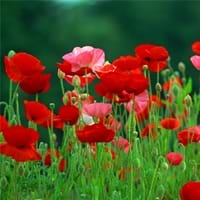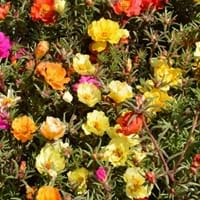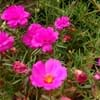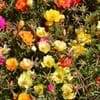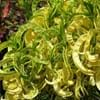Life Span
Perennial
Annual
Type
Flowering Plants
Flowering Plants
Origin
Eastern Europe, Northern Africa, Western Asia
South America
Types
Corn Rose, Field Poppy
Not available
Number of Varieties
Not Available
Habitat
Fields, Forest edges, meadows
gardens, Roadsides, Waste areas
USDA Hardiness Zone
3-11
5-11
AHS Heat Zone
12 - 1
12 - 1
Sunset Zone
A1, A2, A3, 1a, 1b, 2a, 2b, 3a, 3b, 4, 5, 6, 7, 8, 9, 10, 11, 12, 13, 14, 15, 16, 17, 18, 19, 20, 21, 22, 23, 24
A1, A2, A3, H1, H2, 1a, 1b, 2a, 2b, 3a, 3b, 4, 5, 6, 7, 8, 9, 10, 11, 12, 13, 14, 15, 16, 17, 18, 19, 20, 21, 22, 23, 24
Habit
Upright/Erect
Prostrate/Trailing
Flower Color
Red, Ivory, Black
Red
Flower Color Modifier
Bicolor
Bicolor
Fruit Color
Sandy Brown, Chocolate
Not Available
Leaf Color in Spring
Light Green, Gray Green
Green
Leaf Color in Summer
Light Green, Gray Green
Green
Leaf Color in Fall
Light Green, Gray Green
Green
Leaf Color in Winter
Light Green
Light Green
Leaf Shape
Small, flat and dissected
Needle like
Plant Season
Summer
Summer, Fall
Sunlight
Full Sun, Partial Sun
Full Sun
Growth Rate
Very Fast
Very Fast
Type of Soil
Loam, Sand
Loam, Sand
The pH of Soil
Acidic, Neutral, Alkaline
Neutral, Alkaline
Soil Drainage
Well drained
Well drained
Bloom Time
Early Summer, Summer
Indeterminate
Tolerances
Drought
Drought, Heat Tolerance
Where to Plant?
Container, Ground
Container, Ground, Pot
How to Plant?
Seedlings
Seedlings
Plant Maintenance
Medium
Low
Watering Requirements
Do Not over Water, Never Over-water, Over-watering can cause leaf problems or root diseases, Prefer drip-irrigation instead of Over-head watering, Water when top layer of soil becomes dry
Average Water Needs
In Summer
Lots of watering
Lots of watering
In Spring
Moderate
Moderate
In Winter
Average Water
Average Water
Soil pH
Neutral
Acidic, Neutral, Slightly Acidic
Soil Type
Loose, Well drained
Well drained
Soil Drainage Capacity
Well drained
Well drained
Sun Exposure
Full Sun
Full Sun
Pruning
Cut or pinch the stems, Remove damaged leaves, Remove deadheads
Remove damaged leaves, Remove dead branches, Remove dead leaves, Shearing
Fertilizers
Compost, fertilize in growing season
Requires high amount of nitrogen
Pests and Diseases
Red blotch
Aphids, Botrytis Blight, Brown Spots, Gray mold, Root rot, Stem rot
Plant Tolerance
Cold climate, Drought
Drought, Heat Tolerance
Flower Petal Number
Single
Semi-Double
Foliage Texture
Medium
Fine
Foliage Sheen
Matte
Matte
Attracts
Butterflies
Butterflies
Allergy
Hives
Not Available
Aesthetic Uses
Beautification, Landscape Designing, Showy Purposes
Beautification, Bouquets, Cottage Garden, Ground Cover, Showy Purposes
Beauty Benefits
Not Available
Skin Problems
Environmental Uses
Food for insects
Air purification
Medicinal Uses
anti-cancer, Bronchitis, Cough, Jaundice
Depurative, Insect Bites, Liver problems, Snakebite, Swelling
Part of Plant Used
Flowers, Seeds
Flowers, Leaves, Stem, Whole plant
Other Uses
Employed in herbal medicine, Used As Food, Used for its medicinal properties, Used for producing cooking oil
Showy Purposes, Used As Food, Used for its medicinal properties
Used As Indoor Plant
No
No
Used As Outdoor Plant
Yes
Yes
Garden Design
Container, Feature Plant, Mixed Border, Showy Tree
Cottage garden, Edible
Botanical Name
PAPAVER rhoeas 'American Legion'
PORTULACA grandiflora
Common Name
American Legion Field Poppy, Corn Poppy, Field Poppy
Moss Rose, Portulaca, Sundial Scarlet Portulaca
In Hindi
मकई पोस्ता
Portulaca
In German
Klatschmohn
Portulak
In French
Coquelicot
portulaca
In Spanish
amapola de maíz
Portulaca
In Greek
καλαμπόκι παπαρούνας
Portulaca
In Portuguese
Corn Poppy
Portulaca
In Polish
Corn Poppy
Portulaca
In Latin
corn Poppy
Portulaca
Phylum
Anthophyta
Magnoliophyta
Class
Magnoliopsida
Magnoliopsida
Order
Ranunculales
Caryophyllales
Family
Papaveraceae
Portulacaceae
Clade
Angiosperms, Eudicots
Angiosperms, Core eudicots, Eudicots
Tribe
Papaver
Not Available
Subfamily
Papavereae
Not Available
Season and Care of Corn Poppy and Portulaca
Season and care of Corn Poppy and Portulaca is important to know. While considering everything about Corn Poppy and Portulaca Care, growing season is an essential factor. Corn Poppy season is Summer and Portulaca season is Summer. The type of soil for Corn Poppy is Loam, Sand and for Portulaca is Loam, Sand while the PH of soil for Corn Poppy is Acidic, Neutral, Alkaline and for Portulaca is Neutral, Alkaline.
Corn Poppy and Portulaca Physical Information
Corn Poppy and Portulaca physical information is very important for comparison. Corn Poppy height is 30.00 cm and width 20.30 cm whereas Portulaca height is 10.20 cm and width 20.30 cm. The color specification of Corn Poppy and Portulaca are as follows:
Corn Poppy flower color: Red, Ivory and Black
Corn Poppy leaf color: Light Green and Gray Green
Portulaca flower color: Red
- Portulaca leaf color: Green
Care of Corn Poppy and Portulaca
Care of Corn Poppy and Portulaca include pruning, fertilizers, watering etc. Corn Poppy pruning is done Cut or pinch the stems, Remove damaged leaves and Remove deadheads and Portulaca pruning is done Remove damaged leaves, Remove dead branches, Remove dead leaves and Shearing. In summer Corn Poppy needs Lots of watering and in winter, it needs Average Water. Whereas, in summer Portulaca needs Lots of watering and in winter, it needs Average Water.
